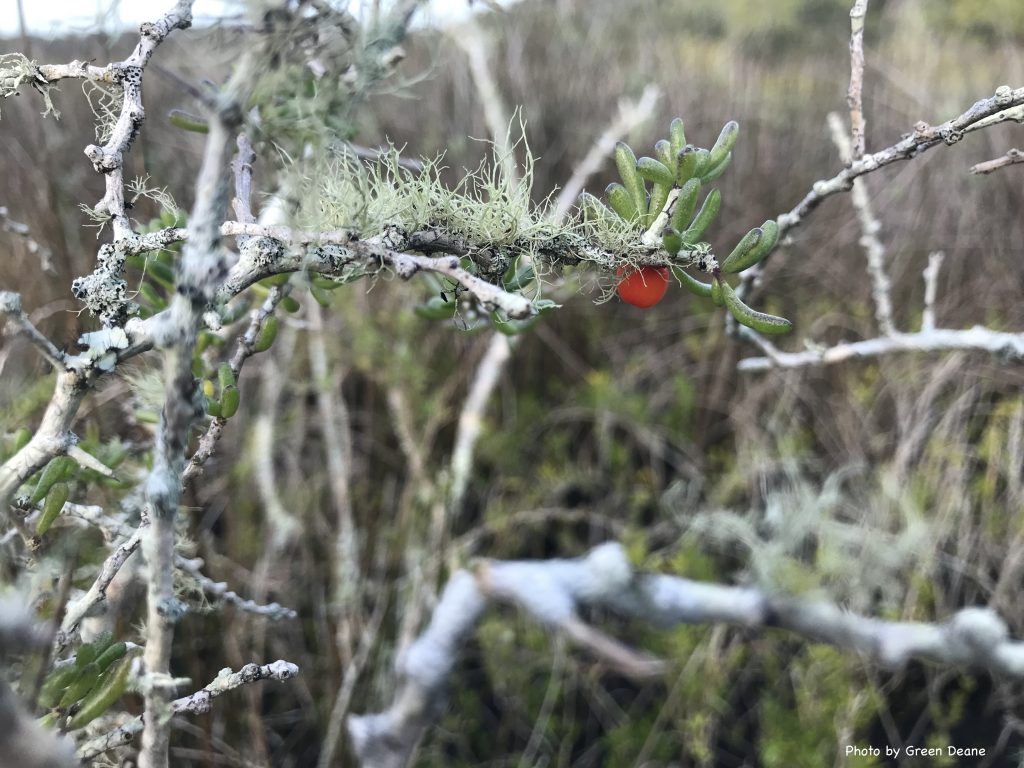
A sweet Goji berry and Ramalina, a lichen — also edible — at Spruce Creek. Photo by Green Deane
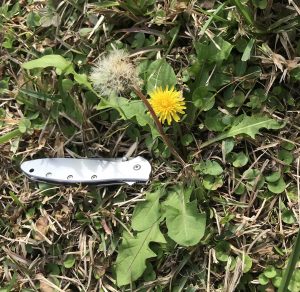
Dandelions are edible but uncommon here. Photo by Green Deane
As you can see above there was one Goji berry still hanging on late Saturday. While called the Christmasberry it can be in fruit until April. We also saw drying fruit on a Foresteria and blueberries in blossom. They’ll ripen into berries about April. (April is the big month locally. Most the plants that fruit do so about April… the aforementioned and blackberries, cherries, wild onions, loquats et cetera.) Also worth mentioning were some plump Smilax berries we saw. They taste best when they look like raisins. I take black plump ones home then dehydrate them. At Eagle Lake Park in Largo the stinging nettles were more than a foot high, which is maximum height for our local variety, Urtica chamaedryoides. It has a horrible sting. The hollies are fruiting non-edibe berries and we saw a dandelion, rare for Florida. They like acidic soil and cool weather. Florida is a hot limestone plate. So we see them here and there mostly during the cooler months.
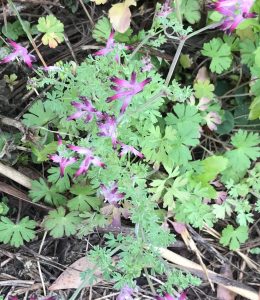
Fumaria is not edible but is often found at the same time and place as Stork’s Bill and Cranesbill.
Also found this time of year are wild geraniums, usually Cranesbill or Stork’s Bill. (Why one is one word and the other two-words possessive is unknown.) Botanically they are Geranium carolinianum and Erodium circutarium. Neither is great foraging. In fact both are more medicinal than edible but they seem to get mention in a variety of foraging books. The problem is they can be extremely bitter. You might be able to toss a little bit of both in a salad or make a tea from the leaves but that’s about the extent of it. If you have what you think is a Cranesbill or a Stork’s Bill but it has more of a bottle brush blossom than five petal you might have the non-edible Fumaria, see photo left. It comes up this time of year and from a distance the leaves can remind one of the wild geraniums. They like to grow in the same location and have pink or white blossoms. I’ve never found a reference to this but some people have told me they also eat roots of the geraniums. To read more about the “bills” go here.
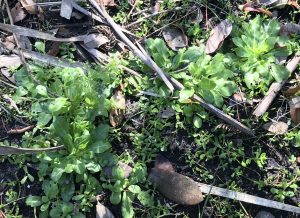
Brookweed in Spruce Creek Park.
You probably heard the old saying: “A man with a hammer sees nails everywhere.” That is relevant to foraging. Once you learn what a particular plant looks like you will see it more often. That’s what’s happened with me and Samolus valerandi. Brookweed. I first noticed in Jacksonville a couple of years ago. Then perhaps half a year later in Sarasota. A year after that I noticed it in Palm Harbor and Sunday in Port Orange. It likes to be near fresh water, can tolerate some brackish water and is a small plant with a naked flower/seed spike. Fortunately its flowering arrangement makes it easy to identify. Not much is written about the species, few published books cover it. Mild young leaves are edible raw and are high in vitamin C. That was important when scurvy was a common problem (which is making a comeback in some cities.) Persimmon leaves also have high amounts of vitamin C as dose Firebush berries. Brookweed has a bit more history of use in Europe. Usually young and tender leaves are what’s eaten, older leaves turn bitter. You can read about Brookweed here.

Classes are held rain or shine (but not during hurricanes.)
Foraging Classes: My out-of-town class this weekend is West Palm Beach, always an interesting sub-tropical walk. Looks like the weather will be good that class and for the Sunday’s class in east Orlando,
Saturday February 19th, Dreher Park, 1200 Southern Blvd., West Palm Beach, 33405. 9 a.m. to noon, meet just north of the science center.
Sunday February 20th, Blanchard Park, 10501 Jay Blanchard Trail, Orlando, FL 32817. 9 a.m. to noon. Meet at the pavilion next to (east of) the tennis courts.
Saturday February 26th, Tide Views Preserve, 1 Begonia Street, Atlantic Beach Fl 32233 (near Jacksonville Fl.) 9 a.m. to noon. Meet at the parking lot.
Sunday February 27th, Mead Garden: 1500 S. Denning Dr., Winter Park, FL 32789. Meet at the bathrooms. 9 a.m. to noon.
Saturday March 5th, John Chestnut County Park: 2200 East Lake Road, Palm Harbor, FL 34685. Meet at the trail head of the Peggy Park Nature Walk, pavilion 1 parking lot. 9 a.m. to noon.
Sunday March 6th, Mead Garden: 1500 S. Denning Dr., Winter Park, FL 32789. Meet at the bathrooms. 9 a.m. to noon.
Saturday/Sunday May 7th & 8th, Honea Path, South Carolina, classes at 9 a.m. and 1 p.m. each day.
For more information, to pre-pay or sign up go here
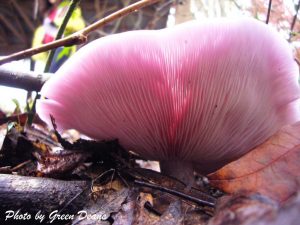
The Blewit’s violet color quickly fades. Photo by Green Deane
It was with great joy that I found this “choice” wild mushroom eight years ago at Boulware Springs. It’s a Blewit, or Lepista nuda. At first glance it looked like the plastic top of some discarded can under a vine but upon investigation it was a large, beautiful mushroom. At the time I took it to the EarthSkills gathering which then was in Hawthorn Florida, some 20 miles south of Gainesville. I taught on site the day before and there were several mushroom experts in attendance. That was my first mistake. I thought I was safe there. Was I wrong. Have you ever been mugged for a mushroom? There were many offers to take it off my hands but it went home with me and into me. After years of finding non- or barely-edible mushrooms it was my turn to discover a choice one. I revisit that location every year in mid-February, Blewit’s best season locally, and the coldest. Boulware Springs is also where I find Black Trumpet mushrooms beside trails under hickories when chanterelles are also out.
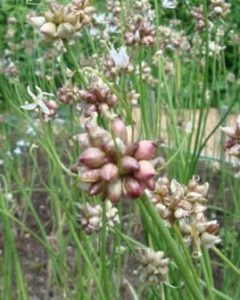
Wild Garlic will be cloving soon.
In Largo Sunday we visited my favorite place for Wild Garlic. A native that is about nine inches high now but will be blossoming in a few weeks. What makes this Allium curious is that it puts a bulb on at the bottom end — like a pearl onion — and garlic cloves at the top end. This particular species is very pungent. It’s great for cooking or as a trailside nibble as long as you don’t mind strong garlic breath. Before it blossoms the entire plant can be used to make a very nice soup. Oddly there’s no extant record of southeastern natives using the plant and only three peoples had names for it, the Alabama, Chickasaw, and Muskogee. I call it good. I also spread the cloves around in damp spots. They start growing in late December or early January.

Green Deane videos are now available on a USB.
My nine-DVD set of 135 videos has been phased out and replaced by a 171-video USB. The USB videos are the same videos I have on You Tube. Some people like to have their own copy. The USB videos have to be copied to your computer to play. If you want to order the USB go to the DVD/USB order button on the top right of this page or click here. That will take you to an order form. Or you can make a $99 donation, which tells me it is for the USB (include a snail-mail address.) I’d like to thank all of you who ordered the DVD set over the years which required me to burn over 5,000 DVDs individually. I had to stop making them as few programs now will read the ISO files to copy them.

Green Deane Forum
Want to identify a plant? Perhaps you’re looking for a foraging reference? You might have a UFO, an Unidentified Flowering Object, you want identified. On the Green Deane Forum we — including Green Deane and others from around the world — chat about foraging all year. And it’s not just about warm-weather plants or just North American flora. Many nations share common weeds so there’s a lot to talk about, such as the one to the left. There’s also more than weeds. The reference section has information for foraging around the world. There are also articles on food preservation, and forgotten skills from making bows to fermenting food. Recent topics include: California Wild Mushroom Parties, A Good Reason To Eat Wild Garlic, Black Walnuts and Amaranth, Sea Salt and Plastic, Wild Mustard? Heavy Metals. Oriental Persimmons. What is it? Pine Cough Drops and Needles, Skullcap, Malodorous Plant? Another NJ Tree, Maypop? Roadside Plant, Unknown in Sudan, Please Help Identify, and Preserving Prickly Pear Bounty. You can join the forum by clicking on the button on the upper right hand side of this page.
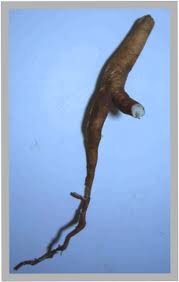
Spurge nettle root, photo by Green Deane
A young mother wrote to me asking how to get rid of the spurge nettle, Cnidoscolus stimulosus. She said she had a couple of acres and the plants were all over the place, bothering her children and her dog. I wrote back saying “lucky you. The roots are quite delicious, eat them.” She wrote back saying that I did not understand her. She wasn’t interested in eating them: She wants to get rid of them. I replied that I had two good students living very near her who would love to visit her property on a regular basis and dig them up. I added that she could mow the area constantly and in a few years the roots will become exhausted and the plants will die off.
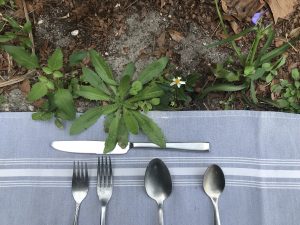 The exchange led me to wonder what was missing? Or better still, what is, as they used to say, the operant factor? That factor is for most people food comes from a quick stop shop or a grocery store. most people don’t cook any more let alone forage or raise food. In that way of thinking food does not come out of the ground in your suburban back yard. Even gardeners are viewed as a throwback and a tad eccentric. Here is someone who has a replenishing pantry of a staple crop that must be gotten rid of. Those spurge nettle roots easily could represent hundreds of pounds of wholesome, tasty, food most of the year that does not have to be purchased or stored. Perhaps it’s time to consider a different approach: Train the dog and kids to stay away from the plants,the stinging plant is doing its best but it’s not enough. To read about the spurge nettle go here.
The exchange led me to wonder what was missing? Or better still, what is, as they used to say, the operant factor? That factor is for most people food comes from a quick stop shop or a grocery store. most people don’t cook any more let alone forage or raise food. In that way of thinking food does not come out of the ground in your suburban back yard. Even gardeners are viewed as a throwback and a tad eccentric. Here is someone who has a replenishing pantry of a staple crop that must be gotten rid of. Those spurge nettle roots easily could represent hundreds of pounds of wholesome, tasty, food most of the year that does not have to be purchased or stored. Perhaps it’s time to consider a different approach: Train the dog and kids to stay away from the plants,the stinging plant is doing its best but it’s not enough. To read about the spurge nettle go here.
On a personal note: I am still trying to find a place to rent or buy in southwest Florida. I have a line on something in central Florida but I’d like to have an alternative. Can be a fixer-upper 50 miles from the coast as long as it is zoned agricultural. If you know of place or anyone please contact me: GreenDeane@gmail.com
This is my weekly newsletter #495. If you want to subscribe to this free newsletter you can find the sign-up form in the menu at the top of the page. My website, EatTheWeeds.com, which is data secure, has over 1500 plants on it in some 428 articles. I wrote every one myself, no cut and paste.
To donate to the Green Deane Newsletter click here.


Good luck finding a place in south West FL…I live between Venice and Englewood..sure would LOVE you to live around here. I will keep my “eyes peeled’
There are place but they want a third of a million for a $70,000 pile of bricks.
I know you deal with mostly central and south Florida, but dandelion is very common in North Florida, not at all rare.